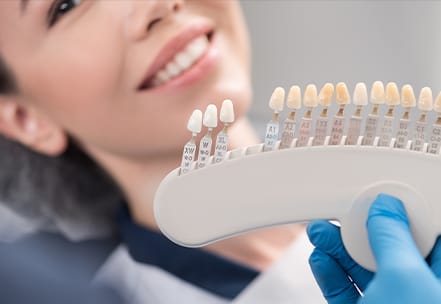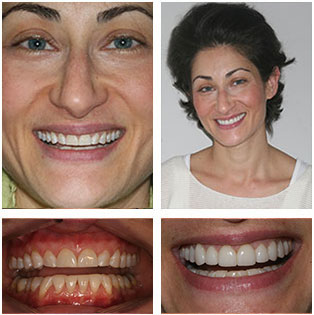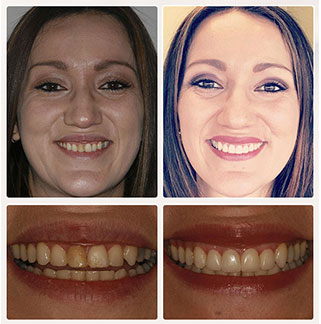Porcelain Veneers
Porcelain dental veneers are some of the most popular and effective cosmetic dentistry options available. One of the reasons for this is that porcelain veneers are able to address so many common concerns. In fact, porcelain veneers can have such a positive effect on the appearance of your teeth that you will end up with a completely renewed smile! Advanced porcelain veneer treatment techniques combined with the experience of our cosmetic dentist, Dr. Harold A. Pollack, can ultimately restore your smile with beautiful results.
- Porcelain Veneers Benefits
- Porcelain Veneers Candidates
- Porcelain Veneers Vs. Dental Crowns
- Types of Veneers
- Porcelain Veneers Process
- Porcelain Veneers Results
- Porcelain Veneers Cost
- Porcelain Veneers vs. Teeth Whitening
- Porcelain Veneers and Instant Orthodontics
- Porcelain Veneer Alternatives
- Porcelain Veneers FAQs
What Are the Benefits of Porcelain Veneers?
While porcelain veneers are primarily focused on improving cosmetic dental concerns, they can also correct certain functional issues as well. Some of the many benefits associated with porcelain veneers include their ability to effectively address:
- Spaces and gaps between the teeth
- Cracks and chips
- Deep stains and discoloration that may be too severe for teeth whitening on its own
- Teeth misalignment/crooked teeth
- Teeth that look too short or have become worn down over time
In addition, porcelain veneers are color-matched to surrounding teeth to provide the most seamless blend possible, and they are virtually stain-resistant. They are also meticulously designed and created to provide natural-looking results. Plus, porcelain veneers are known for their long-lasting outcomes. With good at-home oral hygiene habits combined with routine dental check-ups, porcelain veneers could last for decades.
Am I a Candidate for Porcelain Veneers?
If one or more of your teeth are affected by severe stains, chips, gaps, mild misalignment, or a “worn down” look, porcelain veneers may be the right option to address these concerns. A consultation with Dr. Pollack is the best way to determine whether you can benefit from this procedure or if an alternative treatment will be a better option to address your needs.
What Is the Difference Between a Dental Crown and a Porcelain Veneer?
A dental crown is a restoration that generally covers the entire tooth, while a porcelain veneer covers the front portion—and possibly the sides—of the tooth. Crowns are often necessary for teeth that have a more severe amount of structural damage caused by decay or injury. Once Dr. Pollack has examined your teeth he can talk with you about whether a veneer or a crown may be the more appropriate option for your needs.
Types of Veneers
Dr. Pollack offers two types of veneers to accommodate his patients’ dental needs and aesthetic goals:
Standard Porcelain Veneers
Standard porcelain veneers at our office are the most common choice among our patients with aesthetic concerns such as gaps, chips, cracks, stains, and misalignments. They also offer protection for a tooth that has been worn down or damaged, and are color-blended to the surrounding teeth. The results of porcelain veneers are expected to last for many, many years with the proper care and routine dental exams and cleanings. Our office has always practiced a conservative approach to cosmetic dentistry, and we strive to provide porcelain veneer procedures that require as little alteration to the existing tooth structure as possible.
“No-Prep” Veneers
Our conservative, minimalist approach also extends to another dental veneer option that can create a picture-perfect smile: “no-prep” veneers. For this type of dental veneer, Dr. Pollack utilizes DURAthin® veneers, which are thin, durable porcelain veneers that can correct smile or tooth imperfections without having to remove any of the natural tooth structure. The preparation of traditional porcelain veneers requires removal of some of the tooth enamel, so no-prep veneers can be a great option for a non-invasive smile makeover. Each patient has a unique smile and Dr. Pollack will take time to understand your goals and the complexity of your case during your personalized cosmetic consultation. This will help determine whether you are a good candidate for DURAthin® no-prep veneers or if standard porcelain veneers are the more ideal treatment for your needs.
How Is the Standard Porcelain Veneers Treatment Performed?
During your consultation with Dr. Pollack and his team members, you will have your teeth examined and discuss your concerns, needs, and goals. Then, after a comprehensive exam is performed and x-rays and study models of your teeth are created, Dr. Pollack will determine whether porcelain veneer treatment is the best option. Dr. Pollack strives to perform this treatment as conservatively as possible, without the need to make excessive alterations to the existing structure of your natural tooth.
Porcelain veneers can serve as an excellent treatment all on its own, or as part of a comprehensive smile makeover that addresses a variety of cosmetic dental concerns. Dr. Pollack will be happy to discuss the porcelain veneers procedure with you during your initial consultation and help you decide whether this treatment is ideal for your needs.
Step 1
A dental exam will be performed and x-rays and study models will be evaluated. We will also take photos of your smile at this appointment, and discuss your needs and goals. Patients must be in good oral health before veneer placement, so we will also evaluate the current condition of your teeth and gums. In many cases, treatment to improve oral health can be performed beforehand so that the teeth and gums are healthy enough for porcelain veneer placement.

Step 2-A
Whitening procedures are next to aid in determining the final shade selection and how many teeth are needed for your Smile Design.
Step 2-B
A diagnostic wax-up (prototype) will be created to show you how the veneers will be able to improve your smile. This wax-up can present the various improvements that can be made by veneers of different shapes and lengths. Your questions and input are encouraged! This process is a collaborative one and we invite total participation.

Step 3
At this visit, we will prepare the teeth for the veneers. Dr. Pollack takes a very conservative and minimalist approach for this stage, aiming to reduce the least amount of original tooth structure possible. In some cases, like the DURAthin® non-prep veneers, modification to the original tooth structure may not be necessary at all. An impression will then be taken and sent to a dental laboratory. The impression will serve as the foundation for creating the veneers. The development of the veneers typically takes about two weeks. Temporary veneers will be placed until the permanent veneers are ready.

Step 4
During this appointment, Dr. Pollack will remove the temporary veneers and show you, in place, the permanent veneers that have been created. You will be able to examine them up close and together to determine whether you are satisfied with how they look. If they meet your expectations, Dr. Pollack will then delicately place the permanent veneers on each tooth, affixing them with a very strong dental cement.

Step 5
You will come back for a follow-up appointment a few days after the veneers are placed. If necessary, Dr. Pollack will make any small adjustments, refinements, or polishes to the porcelain veneers. At the conclusion of this appointment, your porcelain veneer procedure is complete! On many occasions a dental nightguard to protect the veneers is indicated.

What Can I Expect from the Results of Porcelain Veneers?
The combination of Dr. Pollack’s extensive experience performing porcelain veneer procedures along with the precise design of the veneer itself always yields very natural-looking results. In fact, you may not be able to distinguish the veneer from your original teeth once the treatment is complete!
Many patients experience the positive results of porcelain veneers for decades after the initial treatment. However, it’s important to maintain good oral hygiene and to have routine dental check-ups and cleanings. These habits can extend the life of porcelain veneers and keep you smiling brightly well into the future.
Patient Results
How Much Do Porcelain Veneers Typically Cost?
The price of porcelain veneers treatment varies from patient to patient, depending on a number of factors. These factors include the number of veneers that will be necessary to achieve individual goals, the amount of tooth preparation required, and other issues. A member of our team will go over the total cost once your preliminary treatment plan has been created. Our practice offers CareCredit® for dental treatment financing and an array of payment options to help make this procedure as affordable as possible.
Porcelain Veneers vs. Teeth Whitening
Oftentimes, patients weigh the options of porcelain veneers and teeth whitening because both treatments can brighten their smile. Teeth whitening can be advantageous for patients who have mild to moderate yellowing and general discoloration affecting the teeth, as well as surface-level stains. For individuals who have deeper stains and more severe signs of discoloration that cannot be significantly improved with teeth whitening alone, porcelain veneers may be the recommended treatment option. For those who would like to brighten their smile in addition to addressing other areas of concerns among their teeth, such as cracks, gaps, and chips, porcelain veneers can also be helpful for those conditions.
If your primary concern is stains and discoloration that affect the appearance of your smile, our dentist can examine your teeth and recommend whether porcelain veneers or teeth whitening is the best option for your needs.
Instant Orthodontics with Porcelain Veneers
Porcelain veneers are sometimes referred to as “instant orthodontics” when utilized to improve the appearance of mild teeth misalignment. For some individuals, porcelain veneers can be an excellent remedy for orthodontic concerns such as gaps, general misalignment, or uneven teeth. Veneers can often be more desirable for patients when compared to braces or other orthodontic options since porcelain veneers do not require ongoing treatment. In fact, porcelain veneers can typically be placed in about two dental appointments. While veneers will not resolve the orthodontic concern by shifting the teeth into a new position, they can effectively conceal the appearance of misalignment and give the teeth a straighter, more even look.
Are There Alternatives to Porcelain Veneers?
Porcelain Veneers Frequently Asked Questions
Are you considering porcelain veneers? Below, you will find answers to some of the more frequently asked questions about this advanced treatment. If you would like further information, a member of our team at Beautiful Smiles will be happy to assist you.
-
Does the procedure hurt?
Porcelain veneer procedures are typically performed utilizing a local anesthetic, so the process should not be painful. If you suffer from dental anxiety, our practice offers nitrous oxide sedation techniques that can help individuals relax during treatment. We also do everything we can to ensure your comfort while the procedure is performed. -
What is the difference between standard porcelain veneers and “no-prep” veneers?
Standard porcelain veneers are one option for our patients looking to conceal concerns such as gaps, cracks, and irregular tooth sizes. Porcelain veneers are often considered the gold standard for addressing these types of dental concerns, and they can last for many, many years. While Dr. Pollack will try to make these veneer treatments as conservative as possible, some degree of modification to existing tooth structure is necessary.
No-prep veneers are another option available at our dental office. We use DURAthin® dental veneers, which adhere to the front of the tooth without the need for enamel removal. The main difference between DURAthin®veneers and a standard porcelain veneer is that the DURAthin® option retains all of the existing tooth structure without requiring alterations or modifications to accommodate the veneer. On a rare occasion, minimal adjustment of the tooth is necessary.
-
Does insurance cover porcelain veneers?
Since porcelain veneers are primarily considered a cosmetic dental treatment, most insurance policies do not offer coverage. On rare occasions, an insurance company may offer at least partial coverage depending on the individual circumstances; however, porcelain veneers are not usually a covered benefit. With that in mind, our practice strives to make payment for these treatments as convenient as possible. We accept a number of different payment methods, and we work with CareCredit®, which offers qualified applicants the ability to finance their porcelain veneer procedure and pay for treatment on a monthly basis. Our treatment coordinator will be happy to answer any questions you may have about our payment options. -
How strong are porcelain veneers?
Our porcelain veneers are composed of a durable, high-quality ceramic material. This material and the techniques involved in crafting the veneers make the results exceptionally strong and able to last extensive periods of time. -
Do porcelain veneers stain?
Porcelain veneers are stain-resistant. They will not be susceptible to staining agents in food or beverages the way natural teeth would. Years from now, they should look identical to the way they appeared when they were first placed! -
Can porcelain veneers be whitened?
Since porcelain veneers cannot be stained, that also means they cannot be whitened. Porcelain veneers are color-matched to the teeth when they are first placed so that they provide a good blend with surrounding teeth. This is why we often recommend that patients have a teeth whitening treatment before we place the veneers so the restorations can be shaded to blend with teeth that already appear whiter and healthier. For patients who had their veneers placed long ago and would like them to match surrounding teeth that are now whiter in appearance, we can create new veneers that more adequately replicate the color of adjacent teeth. -
Are porcelain veneers reversible?
A standard porcelain veneer procedure typically requires a certain amount of enamel to be removed before the veneer is placed. Although we strive to make any adjustments to the original tooth structure as minimal as possible, these modifications mean that a porcelain veneer treatment is essentially irreversible. With this in mind, patients are so satisfied with the results that they have no desire to have their porcelain veneers removed at a later date!
If you would like more information on porcelain veneers, or if you would like to schedule a consultation with Dr. Pollack, please contact Beautiful Smiles today.



 Standard Prep Veneers
Standard Prep Veneers
